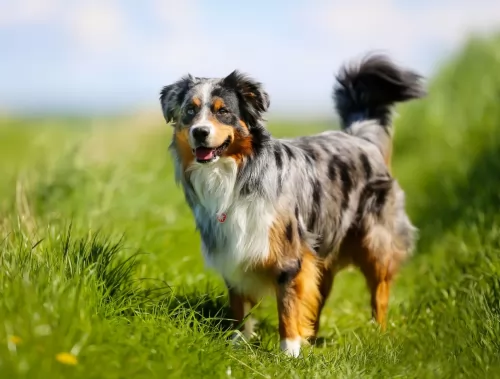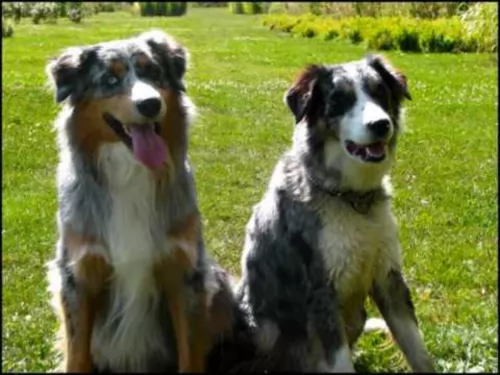 MyDogBreeds
MyDogBreedsGuejae Gae is originated from South Korea but Australian Collie is originated from Australia. Guejae Gae may grow 18 cm / 8 inches higher than Australian Collie. Both Guejae Gae and Australian Collie are having almost same weight. Guejae Gae may live 4 years less than Australian Collie. Both Guejae Gae and Australian Collie has almost same litter size. Both Guejae Gae and Australian Collie requires Moderate maintenance.
Known also as Gaulchae Gae, the Guejae Gae hails from Korea, and falls in the Spitz dog category. The dog is related to the Korean Jindo dog but is slightly larger.
With his sharp canine teeth, the Guejae has been used for hunting and herding, having enough stamina to not easily give up on its prey. The dog isn’t AKC recognized.
 The Koolie, as a breed we know today, originates from Australia. But, before they were breed and imported, they were the mix made of Britain smooth coated blue merle Collie and the Black and Tan Collie from the Highlands of Scotland. The Koolie came to Australia to work as a kennel dog since they are known as the working, farm dog that can adapt to any weather condition. They were bred to be agile and non-aggressive quiet herding dogs, and they have kept most of those good characteristics until today.
The Koolie, as a breed we know today, originates from Australia. But, before they were breed and imported, they were the mix made of Britain smooth coated blue merle Collie and the Black and Tan Collie from the Highlands of Scotland. The Koolie came to Australia to work as a kennel dog since they are known as the working, farm dog that can adapt to any weather condition. They were bred to be agile and non-aggressive quiet herding dogs, and they have kept most of those good characteristics until today.
This is a medium sized dog, standing at roughly 40cm to 58cm and weighing about 16 to 27kg, and because he falls into the Spitz dog category, you’ll find them with the characteristic pointed ears and thick fur.
He can be in a number of colors such as fawn, brown, white, grey or black. The tail curls up over the back too and the dog has a resemblance to the wolf. You can see he is intelligent as has he has bright, alert eyes.
These dogs aren't aggressive and they are known to be gentle dogs who are devoted and loyal to their owners.
He is an active, intelligent, social dog who wants ongoing interaction with his human family. He should never be left alone in the back yard day after day as he becomes lonely and bored. This is terrible to do for any dog breed, but the Guejae Gae won't thrive in a family who doesn't make him 100% part of the family.
He should be allowed indoors with his owner as he is a highly social dog who loves being around his human family, forming deep bonds with them.
His superb intelligence allows him to learn new commands and tricks easily, and this is why he responds well to training and socialization. He makes a great pet for active owners and gets on well with children in the home as well as pets. Because he is somewhat reserved around strangers, he makes a good watchdog too.
 Koolie is a medium bred. Their head is small, with a pointy jaw. Ears are pricked, semi-dropped or dropped. Their coat can be smooth or rough, short or medium length, always with the undercoat. The colours can be Red or Blue Merle, solid Red or Black, sometimes with minimal white or cream speckles. They are usually two-coloured or tricoloured, but some of them are actually one-coloured.
Koolie is a medium bred. Their head is small, with a pointy jaw. Ears are pricked, semi-dropped or dropped. Their coat can be smooth or rough, short or medium length, always with the undercoat. The colours can be Red or Blue Merle, solid Red or Black, sometimes with minimal white or cream speckles. They are usually two-coloured or tricoloured, but some of them are actually one-coloured.
Some Koolie have one or two blue, green or yellow eyes. Eye colour is, of course, affected by the gene that creates the coat pattern and eye colour as well.
They are athletic dogs, with fine bone structure but great stamina. Actually, they were breed to be like that – to work hard, be noticeable among the sheep, eat little and be loyal to one person.
Intelligent, playful, faithful and loving, your Guejae Gae is going to make you a splendid pet – good with other pets in the home as well as with children.
They are good natured pets and easy to train too, so that when he has been trained and socialized, he becomes an even more amicable pet.
Just remember though that these dogs have been used as working dogs and to ensure your Guejae Gae makes you a splendid pet, you want to ensure he has enough exercise to keep him happy and healthy.
 Koolie is naturally energetic, playful and affectionate so they are naturally very good to raise with children.
Koolie is naturally energetic, playful and affectionate so they are naturally very good to raise with children.
They are known as great obedience dog. They are very famous as the tracking dogs.
Some of them are successful as the rescue dogs, therapy dogs or educators for school children.
This is not a type of dog that will be alone in the house, wait for you and then be quiet while you rest. They need a great deal of activity and they are not such great choice for indoor life anyways. The best thing for them would be the large yard, with somebody home most of the time. They are great if raised in a family, with children and active owners. They will be great for a loner at the farm as well since that is in their blood. They need enough place to run, chase, play, rest on the sun and be active as they please. They get affectionate towards their families, but they will be accepting their new home when they are older just fine.
They are very good at learning. Intelligent, yes, but yet very silly and playful to do what is told all the time. They will surprise you with how quickly they will pick up the new trick but not feeling like doing it every time you would like them to. Everything is a play for them, so it would be best if you know how to play, be affectionate and friendly to become a good owner of this breed.
There are always common dog illnesses to watch out for however, and in this spitz-type dog, hypothyroidism is one.
Hypothyroidism in dogs is usually brought on by inflammation of the thyroid gland. Hypothyroidism occurs more often in medium to large dogs as opposed to smaller breeds. The most common signs of low thyroid function in your pet will be loss of fur and excess shedding, weight gain and an inability to tolerate the cold.
Hypothyroid dogs often battle with ear infections as well as skin infections. There are a number of blood tests to confirm a suspected diagnosis of hypothyroidism in your dog.
 If you are careful enough, you will choose your Koolie form patiently chosen breeders, after checking the health history of the pup and the pup’s family. Advisable is to do these things in person and never to buy a Koolie from a pet shop.
If you are careful enough, you will choose your Koolie form patiently chosen breeders, after checking the health history of the pup and the pup’s family. Advisable is to do these things in person and never to buy a Koolie from a pet shop.
Sometimes, pups can be born blind or deaf pups. They have the great chance of joint problems because of their extreme activity. Their need to run, jump and play all the time may result in damage to cartilage and ligaments, especially since they are not aware of their age most of the time.
There is a chance that pup has skin allergies or immune system issues if they are growing on a farm near the chemicals used for plants, so be careful what kind of herbicide you use if you have a Collie.
In some rare cases, they suffer from seizers. If untreated, they can cause death. If you decide to take him to a regular vet check, you will have a happy and playful life together.
He sheds quite a bit and more so in hot weather so he will need to be thoroughly brushed twice a week.
The Guejae Gae is an active dog breed that needs plenty of place to roam freely, and therefore he is a dog breed that will suit life in the country far better than life in the city.
You will need a decent sized yard for him and you should also be prepared to take him on walks and play ball games with him. He is such a social dog and playing with him is something that will strengthen your bond.
As a Spitz type dog, the Guejae Gae has always enjoyed a carnivorous diet. Cheap, poor quality commercially manufactured dog food won’t cut it for these dogs. Home cooked meals with natural ingredients such as chicken, brown rice and vegetables is a good choice as well as adding in some raw meat from time to time.
Always remember when feeding your Guejae Gae that how much your dog eats will depend on his size, age and activity levels. A highly active dog like the Guejae Gae needs wholesome food as well as a constant supply of fresh, cool water.
 Whether you choose canned food or dry food, treats as biscuits or left-overs, the quantity is the safest way of keeping the balanced diet for your Collie. They like raw meat and raw bones. Make sure not to feed them with cooked bones because they can do more harm than good.
Whether you choose canned food or dry food, treats as biscuits or left-overs, the quantity is the safest way of keeping the balanced diet for your Collie. They like raw meat and raw bones. Make sure not to feed them with cooked bones because they can do more harm than good.
Since Koolie coat can be very short with the undercoat or a bit longer with undercoat, bristle brushing every 3 or 4 days will be enough for them. Some of them like the water and some of them don’t and that is perfectly fine since there is no need for a regular bath.
Lots of activities and lots of love. They express their love all the time and you can learn a lot from them actually. They like raw bones and from-the-table delicious treats but make sure not to overfeed them.
Games that need them to be fast and think quickly. Running with them, driving a bike with them (but not on the leash!) would be a great fun for them. Why not leash? They are so playful and happy and they tend to jump and run to the side to chase a butterfly or catch the falling leaf.